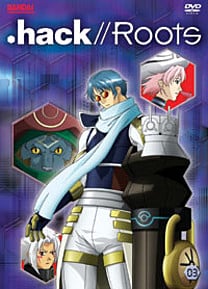Review
by Theron Martin,.hack//Roots
DVD 3
| Synopsis: |  |
||
Naoba/Yata has trapped Oban in order to examine the massive amount of data encapsulated in his left arm, an imprisonment which keeps Oban from contacting other members of the Twilight Brigade. Shino and Haseo draw closer as they wait for Oban's contact and/or return, but the uncertainty proves too much for Sakisaki, who considers not only quitting the guild, but the game itself despite Tabby's best efforts to keep him involved. Tabby also finds events distressing in her own way, especially when Shino's decision to disband the guild strikes at her own motivations for playing the game. All consult Phyllo at one point or another, who runs into his own trouble when he encounters the very dangerous Tri-Edge, who may (or may not) be connected to the mysterious scars now called “signs” and a tragedy which strikes one of the former Brigade Members. |
|||
| Review: | |||
It's been said before, but should be reiterated: if you watch .hack//Roots (or its predecessor .hack//SIGN) for any reason other than what its character interactions reveal about the real people behind the avatars, you will probably be disappointed. Despite its fantasy setting, it actually has little action or true fantasy content. Nor does this volume, which spans episodes 11-14, offer much for plot substance or game play insight. In fact, now that the hunt for the Key of the Twilight plot seems to have climaxed, very little actually happens in this volume beyond one development with long-reaching implications and a couple of lesser ones. The vast majority of the content simply involves characters talking with one another and wondering about what has happened to Oban. Doesn't sound exciting? Although even the most devoted fans may occasionally get impatient with the content, those who allow themselves to get involved with the characters may be surprised at how quickly and smoothly these episodes pass. Each person clearly has their own style of play, own motivations, and own ideals about what he or she wants to get out of the game, and what these conversations reveal about the players can be fascinating. For players like Sakisaki, playing in the world is all about striving towards goals, even if they are vague ones. For players like Yata and Pi, acquisition of power and solving the game's biggest mysteries seem to be the appeal, while others like Phyllo, Shino, and (one would guess) Bset see the game as a social experience and players like Haseo continue because of the relationships they establish in the game. And then we have Tabby, who proves the most interesting character to follow this time around and the one who experiences the most development. We finally see cracks in the chirpy enthusiasm she has, until this point, consistently projected into the game, and start to get an inkling about the person she really is, what has drawn her to this game, and what she desperately needs to get out of the experience. This is where the greatest strength of the series lies. The other great appeals of this volume, as has been traditional for both this series and its predecessor, are its background art, CG effects, and soundtrack. The settings may be the same ones used earlier in the series, but the quality and intricate, inventive detail of the fantastic background pieces never wavers. The CG effects, which mostly involve the gates and flowing water, not only look sharp but integrate well with the normal visuals and always remain interesting to look at. The soundtrack likewise never gets boring as it provides a varied mix of electronic and symphonic sounds in a wide range of styles from wistful melody to operatic vigor to decidedly more sinister tones, including multiple insert songs. Though well-performed, the Yuki Kajiura-produced opener has a mundane sound, while the more distinctive closer by Ali Project may remind some of the themes the duo has done for series like Avenger and Noir. Beyond the background art and some sharp CG effects, the artistry of this span of episodes is nothing spectacular. Character designs, though very inventive and distinctive, are not of especially high quality, and a short-lived but serious breakdown in quality control in their renditions happens early in episode 14. The few monsters who pop up continue to have a cartoonish look, and the non-CG animation, already minimized by a shortage of action content, is unlikely to impress anyone. Appreciation of Ocean Group's English dub will largely come down to a matter of normal sub/dub personal preference. The performances are generally competent, but only Maryke Hendrikse, the voice of Tabby, stands out, if for no other reason than the massive contrast her performance here has to her other major current role (Revy in Black Lagoon). The English script often follows the subtitles word-for-word when lip-synching is not an issue, and never makes significant modifications at other times. Extras this time are strictly limited to company trailers and a release announcement for the Japanese DVDs. If you want thrills, look elsewhere. If you want insight about who the characters really are beyond the (literal) images they project in the game, then this volume may work for you. |
| Grade: | |||
|
Overall (dub) : B-
Overall (sub) : B-
Story : B-
Animation : C+
Art : B
Music : B+
+ Fascinating insight into key characters, quality backgrounds and soundtrack. |
|||
| Production Info: | ||
|
Full encyclopedia details about Release information about |
||